
a.
To identify the given model as exponential growth, exponential decay, gaussian, linear, logarithmic, logistic growth, quadratic or none of above.
a.
Explanation of Solution
Let us consider the following graph
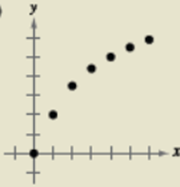
This is a logarithmic model since
b.
To identify the given model as exponential growth, exponential decay, gaussian, linear, logarithmic, logistic growth, quadratic or none of above.
b.
Explanation of Solution
Let us consider the following graph
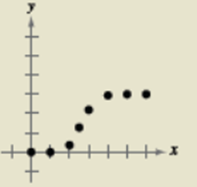
This is a logistic growth model since, it becomes constant after a while.
c.
To identify the given model as exponential growth, exponential decay, gaussian, linear, logarithmic, logistic growth, quadratic or none of above.
c.
Explanation of Solution
Let us consider the following graph
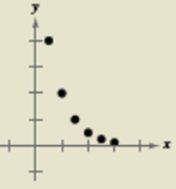
This is an exponential decay model.
d.
To identify the given model as exponential growth, exponential decay, gaussian, linear, logarithmic, logistic growth, quadratic or none of above.
d.
Explanation of Solution
Let us consider the following graph
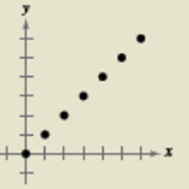
This graph is a linear model.
e.
To identify the given model as exponential growth, exponential decay, gaussian, linear, logarithmic, logistic growth, quadratic or none of above.
e.
Explanation of Solution
Let us consider the following graph
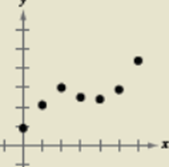
This graph doesn’t represent anything out of the given names.
f.
To identify the given model as exponential growth, exponential decay, gaussian, linear, logarithmic, logistic growth, quadratic or none of above.
f.
Explanation of Solution
Let us consider the following graph
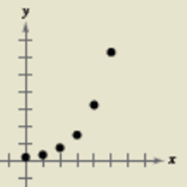
This graph is an exponential model.
g.
To identify the given model as exponential growth, exponential decay, gaussian, linear, logarithmic, logistic growth, quadratic or none of above.
g.
Explanation of Solution
Let us consider the following graph
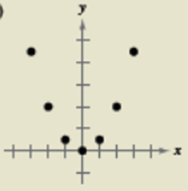
This is a quadratic model, as the value of  is positive or negative, the graph will take the values in positive or negative quadrant for
is positive or negative, the graph will take the values in positive or negative quadrant for 
h.
To identify the given model as exponential growth, exponential decay, gaussian, linear, logarithmic, logistic growth, quadratic or none of above.
h.
Explanation of Solution
Let us consider the following graph
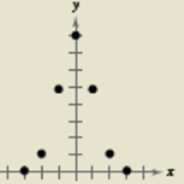
This is a Gaussian model.
Chapter 3 Solutions
EBK PRECALCULUS W/LIMITS
- Solve by DrWz WI P L B dy Sind Ⓡ de max ⑦Ymax dx Solve by Dr ③Yat 0.75m from A w=6KN/M L=2 W2=9 kN/m P= 10 KN Solve By Drarrow_forwardHow to find the radius of convergence for the series in the image below? I'm stuck on how to isolate the x in the interval of convergence.arrow_forwardDetermine the exact signed area between the curve g(x): x-axis on the interval [0,1]. = tan2/5 secx dx andarrow_forward
- A factorization A = PDP 1 is not unique. For A= 7 2 -4 1 1 1 5 0 2 1 one factorization is P = D= and P-1 30 = Use this information with D₁ = to find a matrix P₁ such that - -1 -2 0 3 1 - - 1 05 A-P,D,P P1 (Type an integer or simplified fraction for each matrix element.)arrow_forwardMatrix A is factored in the form PDP 1. Use the Diagonalization Theorem to find the eigenvalues of A and a basis for each eigenspace. 30 -1 - 1 0 -1 400 0 0 1 A= 3 4 3 0 1 3 040 3 1 3 0 0 4 1 0 0 003 -1 0 -1 Select the correct choice below and fill in the answer boxes to complete your choice. (Use a comma to separate vectors as needed.) A basis for the corresponding eigenspace is { A. There is one distinct eigenvalue, λ = B. In ascending order, the two distinct eigenvalues are λ₁ ... = and 2 = Bases for the corresponding eigenspaces are { and ( ), respectively. C. In ascending order, the three distinct eigenvalues are λ₁ = = 12/2 = and 3 = Bases for the corresponding eigenspaces are {}, }, and { respectively.arrow_forwardN Page 0.6. 0.4. 0.2- -0.2- -0.4- -6.6 -5 W 10arrow_forward
 Calculus: Early TranscendentalsCalculusISBN:9781285741550Author:James StewartPublisher:Cengage Learning
Calculus: Early TranscendentalsCalculusISBN:9781285741550Author:James StewartPublisher:Cengage Learning Thomas' Calculus (14th Edition)CalculusISBN:9780134438986Author:Joel R. Hass, Christopher E. Heil, Maurice D. WeirPublisher:PEARSON
Thomas' Calculus (14th Edition)CalculusISBN:9780134438986Author:Joel R. Hass, Christopher E. Heil, Maurice D. WeirPublisher:PEARSON Calculus: Early Transcendentals (3rd Edition)CalculusISBN:9780134763644Author:William L. Briggs, Lyle Cochran, Bernard Gillett, Eric SchulzPublisher:PEARSON
Calculus: Early Transcendentals (3rd Edition)CalculusISBN:9780134763644Author:William L. Briggs, Lyle Cochran, Bernard Gillett, Eric SchulzPublisher:PEARSON Calculus: Early TranscendentalsCalculusISBN:9781319050740Author:Jon Rogawski, Colin Adams, Robert FranzosaPublisher:W. H. Freeman
Calculus: Early TranscendentalsCalculusISBN:9781319050740Author:Jon Rogawski, Colin Adams, Robert FranzosaPublisher:W. H. Freeman
 Calculus: Early Transcendental FunctionsCalculusISBN:9781337552516Author:Ron Larson, Bruce H. EdwardsPublisher:Cengage Learning
Calculus: Early Transcendental FunctionsCalculusISBN:9781337552516Author:Ron Larson, Bruce H. EdwardsPublisher:Cengage Learning





